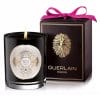
From left: Lela Rose, Marchesa, Houghton
In the eight months that I’ve been engaged, practically every conversation with other brides goes something like this:
Bride-to-be: It was the first dress I tried on!
Me: You really just tried on one dress?
Bride-to-be: [With a smug smile…] It was just meant-to-be!
I can’t blame them; I had been smug once, too. How difficult could it be to find a pretty, white dress in New York City? This is going to be so easy! I told myself, certain of my taste. I even had the guidance of my own personal weddings editor, because somewhat miraculously I became betrothed two months after joining BAZAAR.com. As it turns out, it’s not at all hard to find a pretty white dress—especially online. But what I hadn’t counted on was the crisis-inducing difficulty of choosing—and the addiction that came with finding—just one. I was trying to find a single white dress that encapsulated every facet of my personal style, was deemed appropriately fancy enough to be a “wedding dress”, actually suited me, and didn’t cost more than my dream car.

From left: Houghton, A La Robe, A La Robe, Schone Bridal, Donatelle Godart
A lot of people warned me against trying on dresses outside of my budget, advice I truly tried to take on board. Just a few months earlier I had done the high-end bridal circuit of Bergdorf Goodman and Saks while shopping for my best friend’s wedding dress. She had tried on handfuls of beautifully-beaded, five-figure dresses, none of which she liked all that much (she, like me, was a self-described no-fuss bride who eventually decided to have her wedding dress made, tailored to the specs of her own pared-down, effortless style), so I had resolved not to bother with a similarly expensive rigmarole.
Armed with some foresight, I decided that shopping at the usual bridal salon suspects (Kleinfeld’s, for example) would be a waste of time. Instead, I began feverishly searching BAZAAR Bridal for under-the-radar bridal designers and boutiques that might more readily cater to my sartorial sensibilities. (I often dress in a hodge-podge mix of Annie Hall, with blazers and button downs; Twiggy, with mini skirts and mary janes; and Jane Birkin, with white T-shirts and high-waisted jeans.)
“What I hadn’t counted on was the crisis-inducing difficulty of choosing—and the addiction that came with finding—just one dress.”
Over the next six months, I started following more than 100 bridal Instagram accounts, from notable wedding dress designers like Inbal Dror and Suzanne Harward, to Los Angeles boutiques like LOHO Bride and Solstice Bride, to chic bridal websites like The Lane and big industry players like Martha Stewart Weddings. I also made my first Pinterest board, to try and keep track of all the styles I loved. Three weeks into my engagement last July—during a late-night, hour-long Instagram search that came to define my bedtime routine—I found myself in a deep rabbit hole that led me to the up-and-coming New Zealand bridal brand, A La Robe, and onto its exclusive New York stockist, Spina Bride.
I made an appointment for myself (I prefer to shop alone), and in the spacious sunlit studio, tried on my first ever wedding dress: a high-neck, sleeveless gown with a full skirt by Australian designer Jaimie Sortino. Immediately, I felt like a princess playing dress up. It wasn’t an unwelcome feeling, but a foreign one that I had apprehensions about. With the guidance of Spina’s co-founder Giselle Dubois, I tried on several more styles from burgeoning international designers like Liz Martinez, Lee Grebenau, and Bo and Luca. I twirled in silk, Chantilly lace and soft tulle. (Addictive, see?) But supremely beautiful as they all were, I wondered if any of them truly suited me.
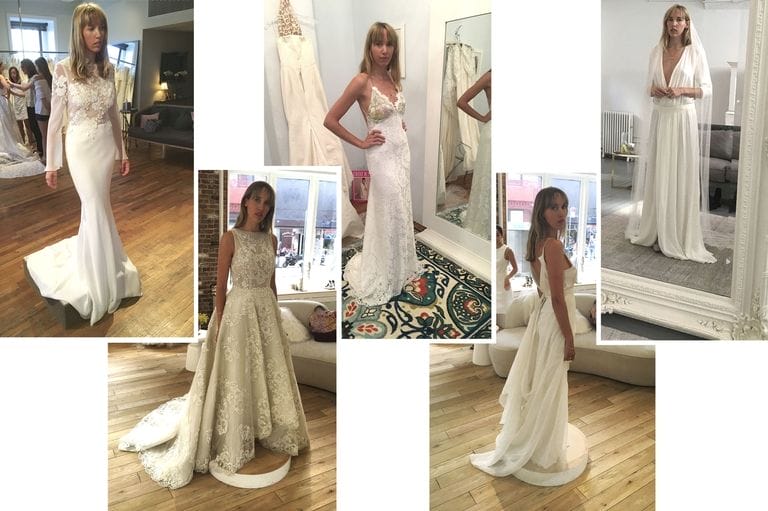
From left: Elizabeth Fillmore, Jaimie Sortino, Elizabeth Fillmore, A La Robe, Donatelle Godart
There is a disclaimer here: I am sample size. I know if I hated my ass or was self-conscious about my stomach, my options would be much more limited. I get it, I had my pick of the wedding dress litter, something I was constantly reminded of by friends and bridal consultants, all of whom liked to mention with an eye roll, everything looks good on you. What they actually meant though, was that I could technically fit into everything. I’m still short by fashion industry standards (5’6″) with disproportionately long legs to a short torso and no defined waist. Add a C-cup bust and suddenly my cool-girl bridal dream of a backless dress became a no-go: they made my athletic waist look chunky and wide. I also have reasonably small shoulders, meaning too much volume automatically overwhelms my slight frame and leaves me looking a little bit like a bobble head, or an asymmetrical lollipop. I conceded the constraints of my body type and immediately cut the amount of dresses on my Pinterest board to half. (Like throwing out a bunch of crap in your closet, this was surprisingly cathartic.)
“I vowed to find something I could wear well, rather than something that, though fashionable, would ultimately wear me.”
Brooklyn boutique Schone Bride was my next target. This time I took my best friend for what I later realized was much needed in-the-moment guidance—wedding dress fatigue is real; after a while everything starts to look the same. I tried on various dresses from designers I had been lusting over—Anais Anette, Daughters of Simoneand Temperley London—before sending photo dispatches to my friends in New Zealand. Everyone agreed these looked nice, but none of them were quite right: a neckline was too high, a strap too thin, a skirt too full. The next stop was Houghton, every fashion bride’s fantasy, where designer Katharine Polk is known for her edgy wedding dresses inspired by the likes of Katharine Hepburn, Bianca Jagger and Patti Smith. This, I thought, is where I’ll find my dress. I tried on 14 styles, each one better than the next. I especially loved the idea of a two-piece set (a bodysuit and skirt) made in mismatching lace.

From left: Carolina Herrera, Vera Wang, Elie Saab, Costarellos, Vera Wang
A week later I attended my friend’s wedding in Upstate New York. The bride, whom I had never seen in a dress prior and will probably never see in one again, looked phenomenal in a soft, low-neck Anne Barge gown with a separate tulle overskirt (which she later wore as a cape on the dance floor). Though the idea of seeing her in any dress at all was strange, her careful choice not only suited her, it felt like a natural and stylish extension of her carefree personality. When I scrolled through photos of the designs I had tried on so far (the count stood at 23), I realized I didn’t see myself; I saw a screen full of pretty, white dresses. In true taking-this-all-too-seriously fashion, I vowed to find something I could wear well, rather than something that, though stylish, would ultimately wear me.
I had my eye on a few new Lela Rose gowns, so my next stop was Gabriella New York Bridal Salon. It was easy to be swayed by Rose’s dreamy full skirts and feathered trains, which, exquisite as they were, all looked a little silly on me with my new mantra in mind. I moved on to some column styles by Lihi Hod and Marchesa. Hanging in my dressing room, they were knock outs, but on me, I wasn’t convinced, and I couldn’t put my finger on why. Sensing a growing unease, my bridal specialist asked if I had tried the New York-based designer Elizabeth Fillmore (I hadn’t), and persuaded me to put on one more dress. Skeptical of her choice but intrigued by her excitement, I agreed. I looked in the mirror, a long simple veil tucked into my hair, and suddenly that elusive This Is It feeling I’ve heard so many other brides describe passed through me like a spell.
“I should never have let so many cooks into the kitchen—nor tried on a dress outside my budget—and was now faced with a new dream dress that I couldn’t realistically afford.”
With total, unironic teary-eyed satisfaction, I left certain the hunt was over. Now it’s time to choose flowers and dinnerware! Wee! There was one slight problem, though. I had severely underestimated my job, where I’m confronted with new things, new collections, and new designers every day. Refreshing our homepage during Bridal Fashion Week and searching for new bridal boutiques to follow on Instagram became an actual, bona fide addiction. What if there’s an even better dress out there? What if it pops up in my feed and I’m asleep and I miss it? I had gone cray-zee. My real downfall, however, came at the launch of Elie Saab’s debut bridal collection. Against my own and everyone else’s better judgement, I made a last minute appointment for the New York trunk show where I tried on a sleek jumpsuit and eight gowns—including the dress that would, in the weeks to follow, become everyone else’s favorite. It had deep pockets with thick apron straps, a low back and a train to rival Kate Middleton’s. It was dramatic yet casual, and it was wholly “me”. Problem was, it was $15,000—before tax.
I had been so certain about the Elizabeth Fillmore, until I wasn’t. Being constantly surrounded by eight fashion editors who have no qualms about letting loose on their unadulterated opinions left me second guessing my first choice. Meanwhile everyone else—my best friend, my mom, and my girlfriends in New Zealand, London, New York and Los Angeles—were stuck on the Elie Saab. I quickly learned that I should never have let so many cooks into the kitchen—nor tried on a dress outside my budget—and was now faced with a new dream dress that I couldn’t realistically afford.
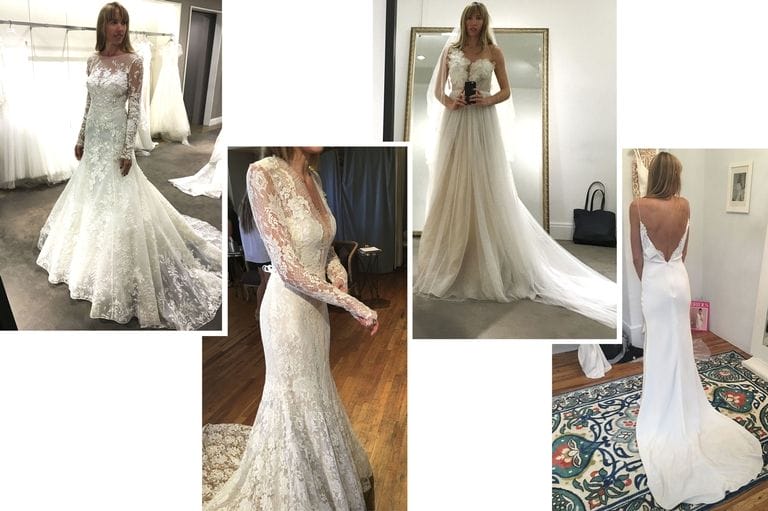
From left: Elie Saab, Lela Rose, Marchesa, Elizabeth Fillmore
At this point, I figured it couldn’t hurt to try on some more options (*buries face in hands*), and proceeded to make appointments at the bridal greats: Carolina Herrera, Vera Wang and Oscar de la Renta. At Herrera, a sleek dress with a big, floppy bow on the bum enticed me enough to try on a backless dress (pointless). That week I also popped in to see the Athens-based Christos Costarellos while he was in town with his ethereal new bridal collection. There, totally committed to the cause, I stood on a toilet in order to allow the samples made for 6’2″ models fall as they should. Two off-the-shoulder styles were winners. I had also been curious about French designers Laure de Sagazan and Delphine Manivet, so for good measure I made appointments to see their dresses, too. I also stopped by the Moda Operandi‘s Madison Boutique to view its exclusive capsule collection, and even returned to Spina twice more to see new styles Giselle had received. By November, after trying on what I counted to be 70 dresses, the iconic London-based bridal boutique, The Mews, had opened in New York—the only New York City stockist of French labels Donatelle Godart and Rime Arodaky, which I had long fawned over from afar. Immediately I fell for two Ossie Clark-style Donatelle Godart dresses, which, with their soft fabric, flowed without any pomp and circumstance. But I was quickly cautioned by my boss, a recent bride in her own right, that in contrast to my plans for a more fancy wedding Upstate, these laissez-faire French-girl dresses were on the casual side; perhaps they belonged at City Hall, or a more laid-back affair. Like a sulky toddler, I reluctantly agreed.
“Totally committed to the cause, I stood on a toilet in order to allow the samples made for 6’2″ models fall as they should.”
At some point my consultant at Vera Wang, Jillian, alerted me to the new well-priced fall 2017 collection (which she deemed anti-pouf) and urged me to swing by during the trunk show over Thanksgiving weekend. By now all my friends thought I was certifiable (as I’m sure do you), so I went alone and without telling anyone. I tried on six dresses, all masterpieces of soft tulle, and one in particular—an understated yet spectacular combination of favored styles I’d tried previously—stood out. Not wanting to be the bride who cried dress, I quietly told Jillian I was positive it was the one, and that I’d be back to try it on with Carrie, my patient weddings editor. I told no one else, no friends, no family. For the first time I wanted to preserve my excitement at having found a dress I genuinely loved in all the quiet ways I had originally hoped. I didn’t need validation and I didn’t want opinions.
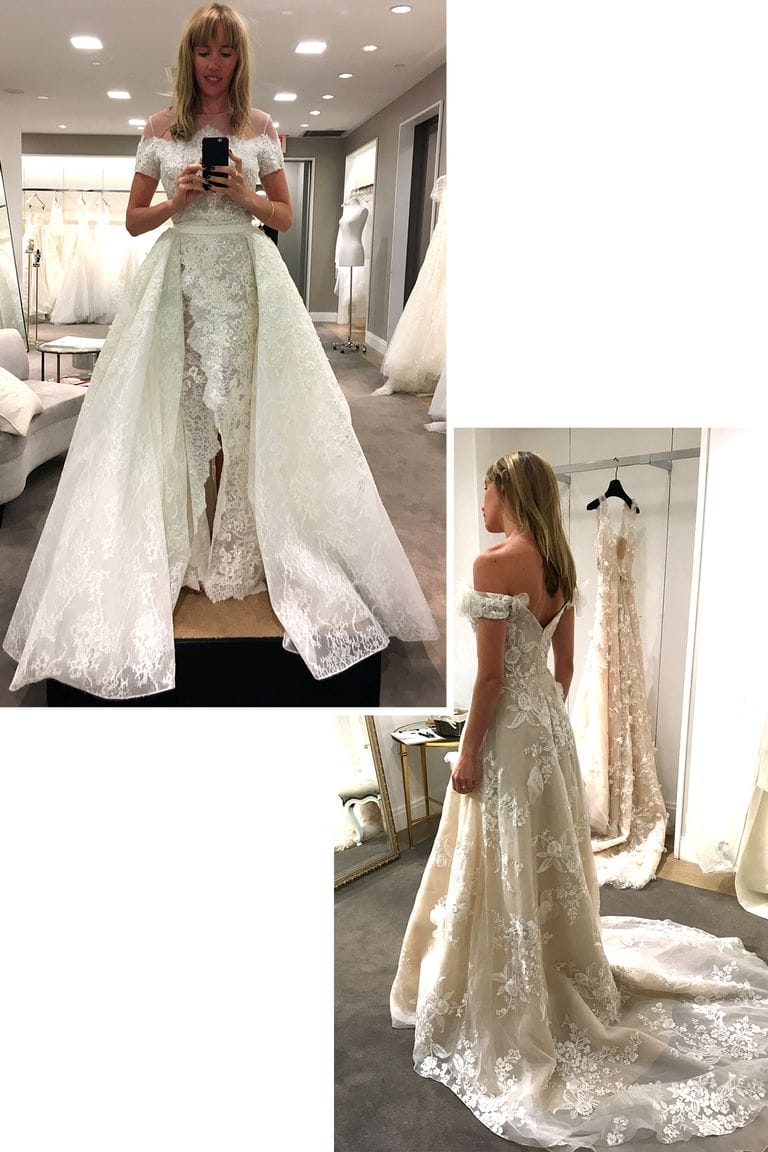
From left: Elie Saab, Marchesa
Cut to a week later. Turns out I was the only bride who tried on that particular style during the trunk show, so it wouldn’t be going into production, meaning it was no longer available to purchase. Wait, what? A wedding dress can really be taken away from a bride just like that? In short, yes. Brides-to-be be warned, I quickly learned it’s a common occurrence in the cut-throat world of wedding dresses. For the first time in this entire process, I finally understood I was dealing with a business, and not a bridal genie—though sometimes it sure did feel like it. For brides, shopping for a wedding dress means people bending to your every whim, treating your quest to find the perfect dress as the single most important thing on their agenda. But in reality, making money is. I suddenly realized the purchase power I wielded, because ultimately, each bridal brand wants you to make that once-in-a-lifetime decision with them. Carrie, knowing this already (and ignoring my downward spiral of distress), took over and asked if the dress could be made for me custom, instead.
Still, I was the opposite of optimistic. I decided I’d really had enough. To my friends, I proclaimed: Wedding dresses are a waste of money, f*ck this entire process. To my fiancé, I declared: I don’t care what I wear anymore. Marrying you is what’s important. I’ll wear a sack! And to myself: What is wrong with me? Why do I care so much about the dress? This is so stupid. Just go to Reformation and call it a day. So I did. I bought a wedding dress on sale for $300, and when it arrived I tried it on in our bedroom while my fiancé stood on the other side of the door. “Are you sure you want to wear polyester to our wedding?” he asked, I think genuinely concerned. The dress was pretty. The deep V-neck flattered my collarbone, the slit accentuated my legs, and the long sleeves gave it a demure feeling of elegance. Dumb questions niggled at me as I stood there: Why can’t I wear a $300 dress to my wedding? Who says I can’t? Why is this such a big deal?
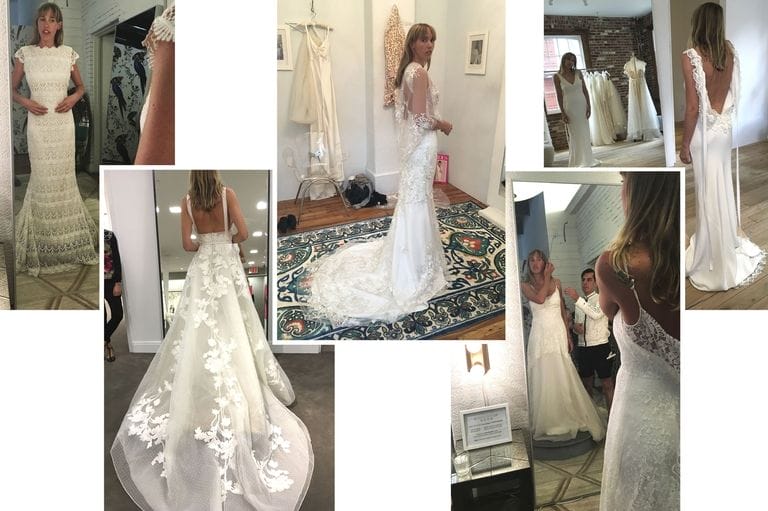
From left: Daughters of Simone, Elie Saab, Elizabeth Fillmore, Anais Anette, A La Robe
Ultimately I was torn, grappling with the pressure of being an editor at a fashion magazine where having avant garde taste is a prerequisite, and where people expect a certain level of cache from your big day. Yet I also pride myself on being the relaxed girl who is fazed by nothing and can conquer anything, someone who certainly doesn’t get flustered by the ultimate decision of privilege: what wedding dress to choose.
I let the Reformation dress sit in its box for five days before finally deciding to send it back. I resolved that I wanted something special, something made just for me, and came to peace with my crazy. And hey, I had 80 options to select from.
Then something magical happened. Six weeks later, Vera Wang said yes.
From: Harper’s BAZAAR US



